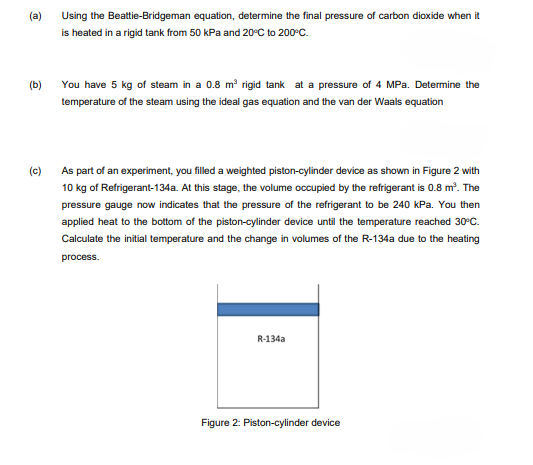(a) Using the Beattie-Bridgeman equation, determine the final pressure of carbon dioxide when it is heated in a rigid tank from 50 kPa and 20°C to 200°C.
(a) Using the Beattie-Bridgeman equation, determine the final pressure of carbon dioxide when it is heated in a rigid tank from 50 kPa and 20°C to 200°C.
Elements Of Electromagnetics
7th Edition
ISBN:9780190698614
Author:Sadiku, Matthew N. O.
Publisher:Sadiku, Matthew N. O.
ChapterMA: Math Assessment
Section: Chapter Questions
Problem 1.1MA
Related questions
Question

Transcribed Image Text:(a)
Using the Beattie-Bridgeman equation, determine the final pressure of carbon dioxide when it
is heated in a rigid tank from 50 kPa and 20°C to 200°C.
(b)
You have 5 kg of steam in a 0.8 m rigid tank at a pressure of 4 MPa. Determine the
temperature of the steam using the ideal gas equation and the van der Waals equation
(c)
As part of an experiment, you filled a weighted piston-cylinder device as shown in Figure 2 with
10 kg of Refrigerant-134a. At this stage, the volume occupied by the refrigerant is 0.8 m?. The
pressure gauge now indicates that the pressure of the refrigerant to be 240 KPa. You then
applied heat to the bottom of the piston-cylinder device until the temperature reached 30°C.
Calculate the initial temperature and the change in volumes of the R-134a due to the heating
process.
R-134a
Figure 2: Piston-cylinder device
Expert Solution
This question has been solved!
Explore an expertly crafted, step-by-step solution for a thorough understanding of key concepts.
This is a popular solution!
Trending now
This is a popular solution!
Step by step
Solved in 3 steps

Knowledge Booster
Learn more about
Need a deep-dive on the concept behind this application? Look no further. Learn more about this topic, mechanical-engineering and related others by exploring similar questions and additional content below.Recommended textbooks for you

Elements Of Electromagnetics
Mechanical Engineering
ISBN:
9780190698614
Author:
Sadiku, Matthew N. O.
Publisher:
Oxford University Press

Mechanics of Materials (10th Edition)
Mechanical Engineering
ISBN:
9780134319650
Author:
Russell C. Hibbeler
Publisher:
PEARSON

Thermodynamics: An Engineering Approach
Mechanical Engineering
ISBN:
9781259822674
Author:
Yunus A. Cengel Dr., Michael A. Boles
Publisher:
McGraw-Hill Education

Elements Of Electromagnetics
Mechanical Engineering
ISBN:
9780190698614
Author:
Sadiku, Matthew N. O.
Publisher:
Oxford University Press

Mechanics of Materials (10th Edition)
Mechanical Engineering
ISBN:
9780134319650
Author:
Russell C. Hibbeler
Publisher:
PEARSON

Thermodynamics: An Engineering Approach
Mechanical Engineering
ISBN:
9781259822674
Author:
Yunus A. Cengel Dr., Michael A. Boles
Publisher:
McGraw-Hill Education

Control Systems Engineering
Mechanical Engineering
ISBN:
9781118170519
Author:
Norman S. Nise
Publisher:
WILEY

Mechanics of Materials (MindTap Course List)
Mechanical Engineering
ISBN:
9781337093347
Author:
Barry J. Goodno, James M. Gere
Publisher:
Cengage Learning

Engineering Mechanics: Statics
Mechanical Engineering
ISBN:
9781118807330
Author:
James L. Meriam, L. G. Kraige, J. N. Bolton
Publisher:
WILEY